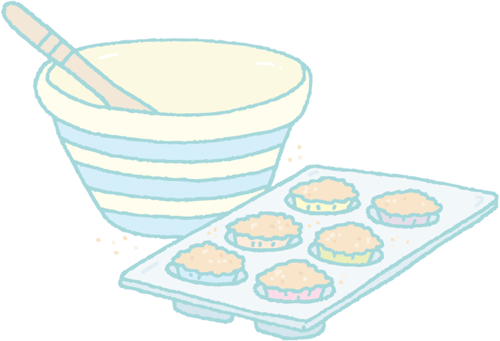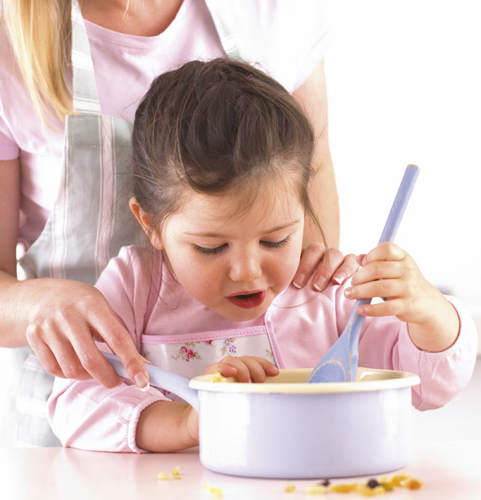|
Your child will be increasingly curious about food, and will love to get involved in family dinners and in the preparation of meals. Even little ones can help in the kitchen, and you’ll be encouraging good habits and teaching skills that will last a lifetime.

| Q: |
Can my toddler eat her evening meal with us later in the evening?
| | A: |
If she’s able to wait, and isn’t too tired and grumpy, it’s a
good idea to allow her to eat with you. She’ll learn table manners and
healthy eating habits, enjoy the sociable aspects of mealtimes, and
probably extend her food repertoire in the process.
While eating
together is to be encouraged as much as possible, late working hours can
make it almost impossible. In this case, don’t worry. Sit down with
your toddler while she eats, and save family mealtimes for weekends and
holidays, until she’s old enough for a later bedtime. You can always get
her bathed and ready for bed, and offer something light such as fruit
and yogurt, or a little toast, when you are ready to eat. Or why not sit
her at the table and let her pick at food on your plate? She’ll enjoy
being a part of what mom and dad do and may be encouraged to try new
things.
|
| Q: |
I normally eat later in the evening with my partner, but I’m
concerned that meals are becoming a lonely experience for my child. What
do you recommend?
| | A: |
Why not try eating a “starter” with your child, and having a
little less later on? If you can manage to eat some of what he is
eating, it will be more effective—he won’t feel that he’s been sidelined
and forced to eat something no one else has to eat. Or why not make a
little salad for you both? He’ll be proud to be offered something
“adult” (even if he only eats a little). Make sure you at least sit with
him to ensure mealtimes are a sociable experience.
|
| Q: |
What foods can I introduce to appeal to the whole family?
| | A: |
As long as family meals are healthy and balanced, anything goes.
Experiment with new flavors from other cuisines, such as Indian,
Italian, or Turkish, and add fun and variety to your diet. Try, also, to
forget the idea that there are “kid” foods and “adult” foods—anything
can be adapted to different levels of sophistication. My chicken meatballs can, for example, be made into a Thai meatball meal with noodles for the rest of the family.
|
| Q: |
Will sitting at the family table encourage my child to try new things?
| | A: |
It will undoubtedly make a difference. First of all, it provides
quality time with your child, and encourages her to think of food and
mealtimes as a positive experience. This goes a long way toward
preventing fussy eating habits.
Secondly, studies show
that kids who eat with their parents regularly have a much better idea
of what foods are healthy, and are more likely to be adventurous eaters.
They learn table manners, and social etiquette, and pick up your
values. In terms of new foods, kids are much more likely to try foods
that everyone else is eating because they want to be equal and
“important.”
Furthermore,
parents and siblings act as role models, and all children are keen to
copy. Displaying your own healthy eating habits can be invaluable for
your child, and encourage her to follow suit. If everyone is eating the
same food, she’ll be much more likely to try them herself. Be patient,
though. If you have extended family meals, your child might become bored
and irritable. Most young children will have eaten their fill in about
20 minutes, so allow her to be “released,” to play on the kitchen floor,
or sit on a parent’s lap.
|
| Q: |
How can I get my child involved in the kitchen?
| | A: |
From the very early days, it’s a good idea to encourage your
little one to help out in the kitchen, from sieving, mixing, grating,
and cracking eggs, to rolling out dough and cutting out shapes .
Children also enjoy being involved in setting the table and helping to
put together a salad, stirring the salad dressing, or spreading butter
on bread.
|
| Q: |
Do you have some fun recipes that my child and I can create together?
| | A: |
Making cakes is always popular—involve him in making the Cupcake caterpillar cake, or the White chocolate crispie squares. He’ll enjoy adding his own toppings to mini-pizzas , dipping fish goujons in bread crumbs, or making his own fruit popsicles.
|
| Q: |
Is it OK to give my child a little ketchup?
| | A: |
Despite its rather tawdry reputation, there is absolutely nothing
wrong with ketchup. In the past, ketchup tended to be high in salt and
sugar, but many newer brands are much lower in these additives, and much
tastier as a result.
Ketchup is, actually,
healthy, too. A number of studies have found that it is a useful
addition to any diet, because it contains a substance called lycopene.
Lycopene is especially concentrated in tomato sauce and paste, and is an
antioxidant (these cancel out the effects of free radicals, which
damage the body’s genetic material and can lead to cancer and a host of
other illnesses). What’s more, lycopene helps to improve eyesight, and
encourages a healthy heart. So a little salt and sugar does not detract
from its clear benefits.
|
| Q: |
How can I sweeten foods without using too much sugar?
| | A: |
First of all, white sugar is the worst of the lot, so even using
brown or unrefined sugars can make a difference. Maple syrup and honey
all have plenty of nutrients, which make them a healthy option. They
sweeten but also add some vitamins and minerals (and, in the case of
honey, some antibacterial properties), whereas sugar is often simply
empty calories. Molasses, barley malt syrup, brown rice syrup, fruit
juice, fruit purées, and agave syrup—a very sweet, natural source of
sugar, derived from a plant—are all healthy options. Whatever you do,
don’t resort to artificial sweeteners, which may not add any calories,
or damage teeth, but offer absolutely no nutrients and may have a
negative impact on health.
|
| Q: |
My child seems to have developed a taste for salt, and won’t eat
anything without a generous sprinkling. What should I do?
| | A: |
There is no doubt that salt can make things taste nicer, and that
it is addictive! If you started him off on jarred foods with added
salt, or he’s become accustomed to salty snacks, fresh healthy food will
undoubtedly taste bland and unappealing. There are a few ways around
this. Firstly, try to make his food more flavorful by adding herbs,
spices, juice, and low-sodium stocks when cooking. If he gets lots of
flavor, he won’t miss the salty taste. For ideas on flavoring kids’
food, see Flavors from Around the World.
Try also, as a family, to leave the salt shaker off the table. If no
one else is doing it, and there is no shaker available, he’ll likely
forget, and the habit will be broken.
|
Did you know…
that your child is much
more likely to eat something that she’s played a part in making?
Children view their accomplishments with huge pride, and will take great
interest in the reaction they get from you. If you all sit down and eat
happily, she’ll undoubtedly do the same, even if she’s fully aware that
some of the ingredients are on her usual “I won’t eat” list. What’s
more, she’ll learn to understand the steps involved in preparing food, a
little about nutrition, and will develop her tastes.

Condiments?
It’s fine to introduce condiments to your little one. Mustard, ketchup (see Is it OK to give my child a little ketchup?),
fresh pickles, salsa, mayonnaise, pesto, and even non-MSG chile dips
are all appropriate for little ones. Remember, though, that toddlers
have very small tummies, and adding extra sauces or ingredients is
likely to fill them up even more quickly, preventing ideal nutritional
intake from their healthy diets, so offer them only in small quantities.
|